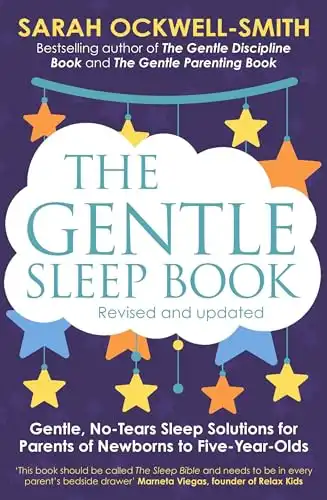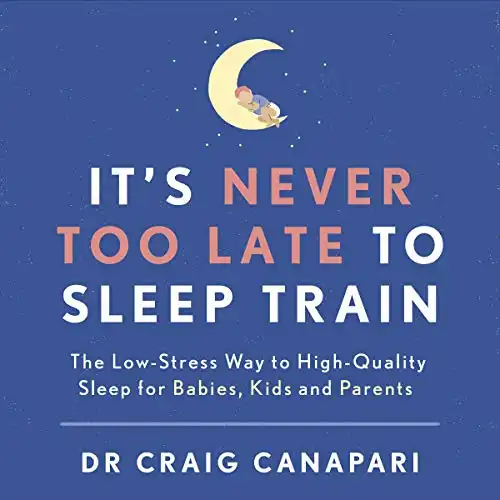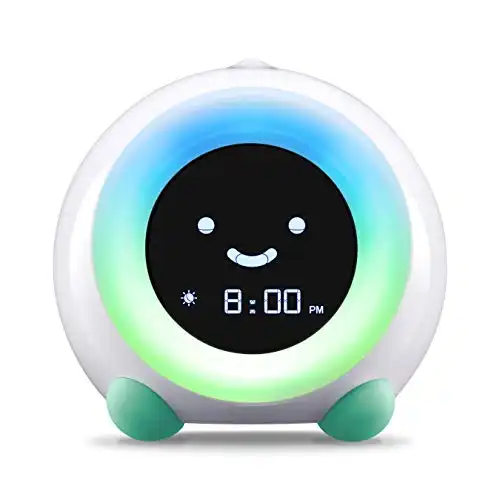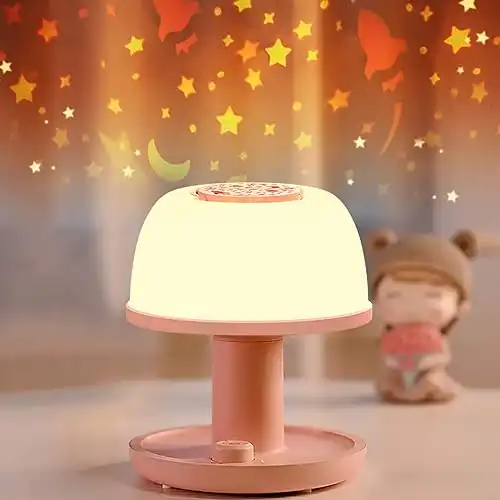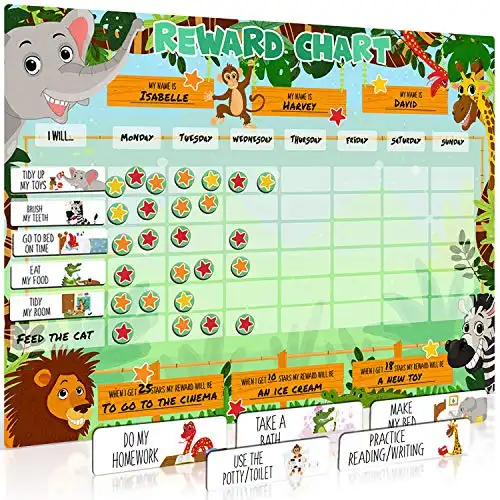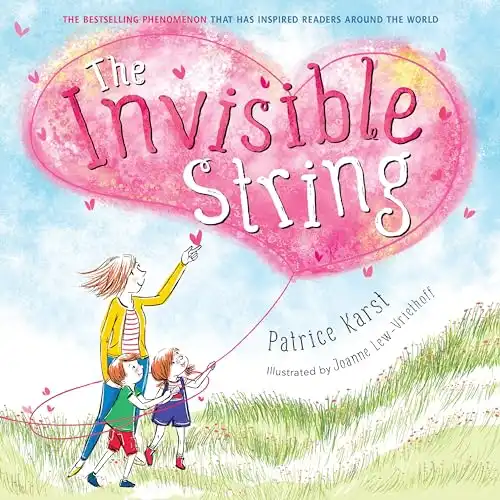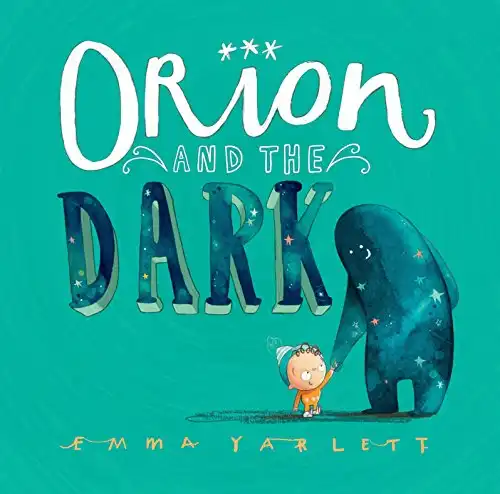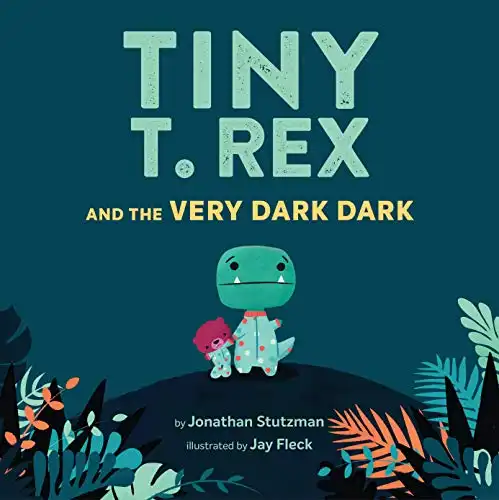Is bedtime a battleground in your home? Does your 4-year-old fight going to sleep and refuse to sleep without you? Do they always get out of bed to find you? Do you find yourself tiptoeing around after they finally fall asleep, praying your toddler will sleep through the night?
As a parent, lack of sleep can leave you drained. But it doesn’t have to be this way.
Inside this guide on sleep training a 4-year-old, you’ll discover proven techniques to transform bedtime from stressful to serene.
With step-by-step methods refined over 40 years of childcare experience, encourage healthy sleep habits, and teach your toddler to soothe themselves to sleep, so you all get the full night’s sleep you deserve in no time!

Table of Contents
Do I Need To Sleep Train My 4-Year-Old?
First things first… Do you actually need to sleep train your 4-year-old?
Ultimately your 4-year-old should be able to fall asleep independently and resettle themselves at night if they wake. This skill is very valuable for their sense of autonomy and ultimately for their sleep quality.
However…
- Is your 4-year-old hyper at bedtime?
- Do they have trouble falling asleep without you or if they wake up frequently during the night?
- Are they constantly stalling at bedtime and repeatedly getting out of bed?
- Has bedtime become later and later?
If you answered yes to any of these questions…
Then yes, you should consider sleep training your 4-year-old.
NOTE: 4-year-old sleep training is about teaching good sleep habits rather than forcing your little one to fall asleep alone.
Why Is Sleep Training Important?
Sleep training is a way of teaching your child to fall asleep and cope with waking at night and falling back to sleep without your presence.
In other words, it helps your 4-year-old to learn to soothe themselves and sleep through the night.
But why exactly is it important?
Firstly, consistent sleep patterns are essential for cognitive and physical growth. At 4 years of age, your child is gaining so many new skills from rapidly developing language, social skills, physical skills, and imagination.
Ensuring your child gets enough rest is a vital part of their growth and wellbeing as their life gets busier and you really want to get a healthy sleep routine in place for school, when they will need to be well rested for busy days.
Quality sleep is therefore vital to support this time of rapid development.
Secondly, establishing good sleep habits can prevent long-term sleep issues. It sets a healthy foundation for your child’s future sleep into adulthood and helps to establish a consistent circadian rhythm.
Remember, you’re not just teaching sleep; you’re teaching self-soothing skills.
Finally, it’s important for your well-being too. When your toddler sleeps better, so does the parent. With more rest, you’re able to be a more patient and attentive parent. This benefits your whole family’s overall happiness and health.
So how can you sleep train a 4-year-old quickly and effectively?
Preparing For Sleep Training
Sleep training an older child is slightly different from sleep training a baby as you are dealing with a child who can understand instructions and consequences.
But you can use this to your advantage to help your little one understand that they need to follow the rules at bedtime, stay in bed, not get up too early, and learn to self-settle when they wake at night.
You can also implement some key sleep practices BEFORE you start a sleep training process.
Not only will you be helping to establish healthy sleep associations and ensure your sleep training efforts are more successful… But you may find you do not need to sleep train at all.
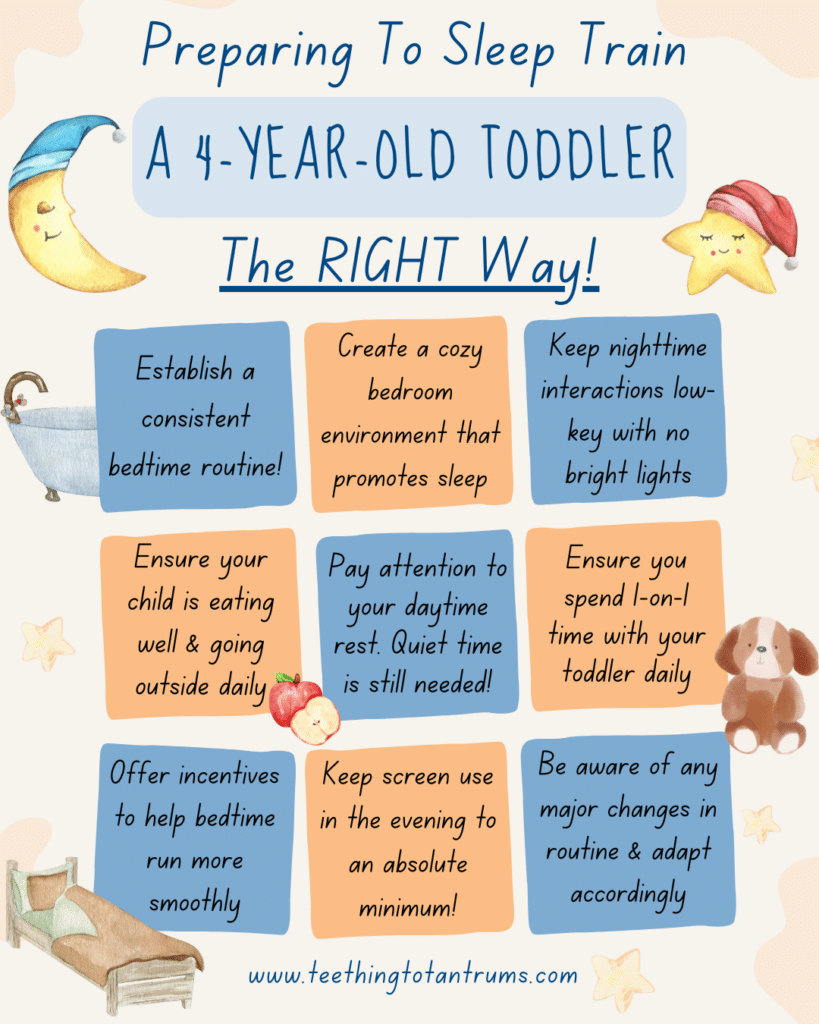
- If you have not done so already, establish a recognizable and regular bedtime routine that includes a warm calming bath, followed by a bedtime drink and or snack, teeth cleaning, a trip to the bathroom then reading a couple of bedtime books together. This routine will become the indicator that bedtime is approaching and should happen at the same time every night, even on weekends!
- Create a sleep-conducive environment in your little one’s room that is dimly lit and at the correct temperature. Make the bedroom cozy with soft furnishings and favorite soft toys to cuddle. Using a ceiling projector or audio app to settle them when it comes time to say goodnight can also help.
- Keep nighttime interactions low-key with little to no talking and no bright lights. Consider using a nightlight to help keep the sleep environment consistent and help address any fears of the dark.
- Ensure your child is eating enough and getting outside in the fresh air and natural light every day. Sunlight is vital to balance your 4-year-old’s circadian rhythm and melatonin levels (both required for healthy sleep) and a balanced diet will help to avoid sugar spikes and crashes. Avoid sugary or caffeinated foods and drinks in the evening and make sure they have plenty to eat during the day so that hunger is not the cause of nighttime waking. 4-year-olds need around 1200-1400 calories per day.
- Pay attention to daytime rest. Most 4-year-olds do not require a daytime nap but some do. And some may require a nap on busy days. I recommend quiet time after lunch to allow your little one to sleep on the days they need to and just have a calm break in the middle of the day if they do not. Both outcomes will ensure your child is not overtired at bedtime which can disrupt the entire sleep schedule.
- Ensure you spend one-on-one time with your little one during the day. A lot of sleep issues result from your 4-year-old just wanting to be with you. Making sure that you have spent some valued time together during the day can fill that emotional cup and make it easier for them to separate from you at bedtime.
- Offer incentives such as a star chart to help bedtime run smoother. For example, a successful bedtime routine followed by staying in bed all night could result in a fun activity reward the next day. Using a toddler alarm clock is a great way to teach your 4-year-old when it is OK to wake up.
- Keep the use of screens to a minimum. In my opinion, restricting screen time at bedtime is a non-negotiable. The blue light emitted from screens will disrupt your 4-year-old’s circadian rhythm and sabotage your sleep training routine.
- Be aware of major changes in routine. If your 4-year-old has undergone a big change such as moving house, the arrival of a new sibling, or starting preschool, be prepared for some clinginess and sleep disruption. Be sympathetic but try not to fall back into bad habits. Offer extra comfort and use books to help promote conversation and more understanding. Hold fire on starting any conventional sleep training for at least a week following a big change.
REMEMBER: It might take some time for your 4-year-old to adjust to these healthy sleep training tips… especially if bedtime has been chaotic up until this point. However, do not be deterred. It is never too late to build healthy sleep associations.
Looking to get your little one to sleep quickly and effortlessly? Check out my Bedtime and Nap Cheat Sheet and master the art of making daytime naps and bedtimes as seamless as possible.
A bedtime & nap cheat sheet so good your little one will ask you to put them to bed...
Laura Williams "This is a life saver! I'm so glad I downloaded your bedtime & nap cheat sheet. My little one actually asked me to put him to bed last night! Unbelievable! Thank you so much!"
Click Here For The FREE Cheat Sheet
Suitable Sleep Training Methods For A 4-Year-Old
Ok, so if you have implemented the tips outlined above and your 4-year-old is still struggling to fall asleep and stay asleep, you will now need to implement a conventional sleep training method alongside these tips.
In many ways sleep training a 4-year-old is more straightforward than training a baby as they understand what you are trying to achieve and the consequences for not doing as you ask.
You will need to take into account your child’s temperament, the reason for their struggles at bedtime, and how you intend to deal with nighttime waking. These can all have a big influence on which sleep training method will be successful.
With that in mind, the top sleep training methods that I would recommend for 4-year-olds are:
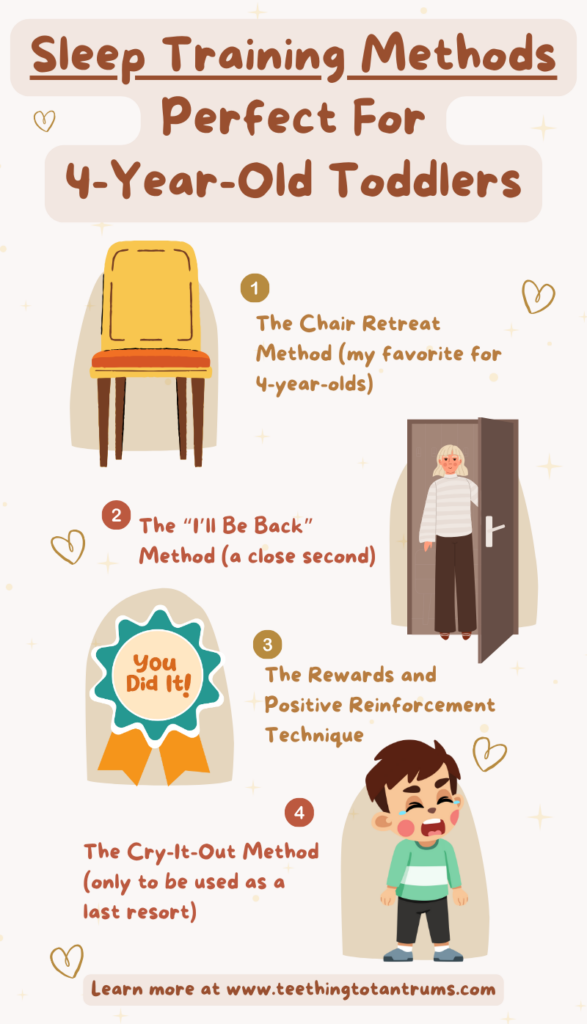
1. The Chair Method
The Chair Method is one of my preferred sleep training methods for toddlers and one that I have found works particularly well for 4-year-olds.
To implement this method, you gradually reduce your presence in their room. Start by sitting near your little one’s bed on a chair or the floor.
The aim is that over successive nights you can increase the distance between you and your little one until they feel comfortable falling asleep without your presence.
If needed, you can start by holding their hand, then progress to no touching. Then each night move a little further away. This lessens separation anxiety and helps your child learn to fall asleep independently without you touching or lying next to them.
You can offer verbal comfort if necessary but you should keep it short and sweet and re-emphasize that they need to go to sleep.
2. The “I’ll Be Back” Method
The I’ll Be Back method is another of my favorite sleep training methods and one that I feel is very appropriate for 4-year-old toddlers.
To make the most of this method, tell your little one that you have to go and do a boring chore and you will be back in a few minutes.
Remember that this age group has serious FOMO so make your reason for leaving as boring as possible (laundry, emails, and cleaning are all good options), and reassure your toddler that you’ll return in a few moments.
Ensure that you do return as promised and repeat this process, gradually extend the time you are away doing whatever you have told them that you need to do.
(PS: you don’t have to go and do emails… it’s simply to stop your toddler from wanting to join in)
The crucial aspect of this sleep training method is that you return as promised.
Your return will help build your toddler’s trust in you and over time you can gradually extend the time you are away and eventually they will be falling asleep alone before your first return.
3. Using Rewards and Positive Reinforcement
As I mentioned earlier, reward charts can be very effective in helping a toddler learn to sleep independently.
This is because at 4 years old, your little one can understand the concept of success and consequences and will always want to work towards a reward.
Using a sleep chart to track behavior and giving incentives like stickers or an extra bedtime story for staying in bed will help your 4-year-old see the positive effects of this “sleep training technique”.
4. The Cry It Out Method
The Cry It Out Method is always my last result for sleep training children as I believe you can have great sleep success without needing to let your little one cry themselves into exhausted sleep.
However…
If all of my sleep tips and previous sleep training techniques have failed, sometimes have no option but to try the cry-it-out method.
The principle is simple and involves letting your child cry until they fall asleep.
Some experts believe this method can be effective without causing harm over the long term and for the particularly stubborn or persistent 4-year-old, it can work.
However, you must know that this method is not for the faint-hearted and you must be able to hold your resolve when your toddler is crying out, screaming, and yelling for you.
NOTE: As your child is now sleeping in their own bed, you will have to install a baby gate or barrier to stop your toddler from coming to find you and to understand that bedtime means bedtime. I do not believe that locking their bedroom door is suitable.
How Long Does It Take To Sleep Train A 4-Year-Old?
To be honest, sleep training a 4-year-old does not have a set duration. It will depend on the individual child, their personality, and what is going on in their daily life.
But if you want a rough guideline, expect the changes implemented by sleep training to establish themselves within 3 to 21 days.
Sleep Training Books I Recommend
When initiating sleep training your 4 year old, it is really helpful to be well-informed about the subject.
Reading this article will have certainly helped!
But reading specific sleep training books will be your goldmine of information.
Remember that your little one is a unique individual and you need to adapt what you learn from a book to suit your baby’s individual needs.
Follow the advice that feels right for you and your baby and don’t embark upon a sleep training method just because it is ‘supposed’ to work quickly.
I have read many books on the subject as well as acquired a lot of experience over the years about what works for which age group.
Here’s a list of my favorites that offer lots of helpful information to help you help your 4-year-old sleep well:
1. No-Cry Sleep Solution for Toddlers by Elizabeth Pantley and Harvey Karp
Unlike many sleep training books, the No Cry Sleep Solution is specifically designed to help parents who are battling with toddler sleep and offers a lot more than just sleep training a 4-year-old for bedtime.
Elizabeth Pantley tackles all manner of sleep issues such as naptime problems, special sleep issues for twins, repeated nighttime visits to parents’ beds and so much more.
If you are looking for a book that tries to look at toddler sleep issues from all angles then this is the one for you. You should also bear in mind that Elizabeth’s approach is gentle and child-centred so there will be no ‘crying it out’ in her solutions.
Gently guiding your toddler to better sleep becomes less of a battle with this book. The No-Cry Sleep Solution aims to provide you with researched, kind methods that respect your child's needs.
Implementing the tips provided feels relevant and doable, as each chapter follows through with advice matched to common situations.
What's truly beneficial is the understanding of sleep you gain. It's a relief to have your experiences validated and then addressed, flipping the script on bedtime struggles.
You're not just reading; you're learning and applying new strategies each night.
- Endorsed by many parents over the last 18 years for its effectiveness
- Focused on gentle techniques
- Includes valuable research insights
- Offers specific advice for 1-5 year olds
- Follows a gentle child-centred approach
- Covers a variety of bedtime issues such as night wakings and getting your toddler to stay in bed
- May not work for every child
- Some information might overlap with books you've previously read
- The solutions require patience and time
2. The Gentle Sleep Book by Sarah Ockwell-Smith
The Gentle Sleep Book covers a wide range of ages from 0-5 years but I have included it in my list as I know from personal experience many parents who have used it and found it invaluable and refer to it as their ‘Sleep Bible’.
I believe this book is ideal for parents who are more relaxed about toddler sleep training but still want to raise a child with healthy sleep habits.
Sarah Ockwell Smith provides a holistic insight into childhood sleep in this book. She explains that very often our expectations are way too high when we expect our little ones to sleep through the night and that we aim for this perfection when they are not developmentally programmed to do so.
In a lot of ways, this is a book that makes parents who are battling with sleep issues feel ‘OK’ with what they are doing whether that be co-sleeping or nursing to sleep.
If you are happy to take this more relaxed approach to sleep training then this is probably the book for you.
- Offers a gentle approach to sleep training
- Offers reliable evidence-based advice
- Deals with night wakings as well as bedtime issues
- Offers advice for each developmental stage
- Covers how to deal with daytime nap issues too
- Mentions that bed sharing is OK... which is not for everyone
- The solutions take time... however, there's never a quick fix
- May be considered more of a parent self-help book than a sleep training book
3. Healthy Sleep Habits, Happy Child by Dr. Marc Weissbluth
A fantastic sleep training resource for parents of toddlers Healthy Sleep Habits, Happy Child by Dr. Marc Weissbluth. It’s full of research-based tips and a step-by-step plan to help you understand the importance of sleep and how to foster it in your little one’s life.
It covers all age ranges but offers a lot of very interesting science-backed advice and information about childhood sleep that aligns with the American Academy of Pediatrics (AAP) sleep training recommendations.
In this brilliant book, backed by decades of research and case studies, Dr. Weissbluth presents the Ferber method, a gentle form of sleep training that involves teaching babies to fall asleep independently with check-ins.
Charts and routines cover naps, nighttime sleep, and adjusting schedules. The book also addresses common issues like bedsharing, co-sleeping, night wakings, and daytime sleepiness giving you an all-inclusive sleep training approach!
- Provides individualized plans based on baby's exact age
- Evidence-based and developmentally appropriate
- Addresses a wide variety of common sleep questions
- Offers flexibility within routines based on baby's temperament and needs
- Teaches independent sleep skills
- Requires consistency to see full effects
- Focuses heavily on rigid routines and schedules
- May be overwhelming amount of information for some
- The adaption of the Ferber Method can be difficult for some babies to handle
4. It’s Never Too Late To Sleep Train by Dr Craig Canapari
Written by a pediatrician, It’s Never Too Late To Sleep Train evolved from a father’s first-hand experience of sleep training his child coupled with years of clinical expertise.
The reason it’s 4th on my list is that the method is focused on letting babies cry it out.
Now, I am not an advocate of the cry-it-out sleep training method… HOWEVER…
A lot of parents have had great success with this book and its techniques and I would not be doing my job if I did not share ALL my knowledge of sleep training a toddler with you.
So if you’ve tried every other option for sleep training and nothing has worked, this book might be the one to change all that.
In many ways, this book is written for the parents who are at the end of their tether. Those who have realized they do not have control over their little one's sleep and need serious help to get things back on track.
While exploring the different sleep training methods available, Dr Craig Canapri focuses on cues and consequences which are both very important to young children and he is on your side against bedtime battles.
As one reviewer puts it Dr Craig Canapari’s advice is ‘clear, funny, actionable, and yet flexible enough to work in various modern family configurations and parenting philosophies'
- Expert knowledge
- Peer-reviewed and approved
- Simple easy to follow strategies
- Aimed at helping children who are often considered outside the optimum age group to sleep train (6 months to 6 years old)
- Focuses on bedtime sleep training and not night wakings
- Some may find some of the methods harsh
- The author does swear occasionally throughout the book
Addressing Common Sleep Training Challenges
When teaching your four-year-old to go to bed peacefully and sleep through the night, it’s normal to face a few hurdles.
- Bedtime tantrums: 4-year-olds can be very strong-willed and will often choose bedtime to challenge your authority. No longer easily persuaded, they can push boundaries, and when you are tired at the end of the day the last thing you feel like doing is having a showdown at bedtime… Take a look at this post to learn how best to tackle this issue if your 4-year-old is going to battle at bedtime: It’s Time To Eliminate 4-Year-Old Bedtime Battles Forever
- Repeated getting out of bed. This is a tough one and requires you to be firm and consistent. Calmly return your child to bed no matter how many times it takes and re-settle them. The Fading Method or I’ll Be Back sleep training method can also be effective. To learn more about handling a toddler who gets out of bed, read the following posts: Tips For When Your Toddler Won’t Stay in Bed and 16 Top Tricks For When Your Toddler Keeps Getting Out of Bed
- Bedtime stalling: 4-year-olds are very good at bedtime stalling so you need to try and stay one step ahead. Offer a bedtime drink or snack before they ask for one and ensure they have one last trip to the bathroom. When your child resists bedtime, you must stay calm and consistent and make your bedtime expectations clear.
- Bedwetting: If your 4-year-old is learning to not wear nappies at night be prepared for the occasional accident. Deal with bedwetting calmly without recriminations. Ensure you have things to hand to make bed changing quick and have a fresh set of P’Js to hand. Then resettle your little one in the normal way.
- Navigating Sleep Regressions. Sleep regressions can occur at any age. At 4 years of age, the arrival of a new sibling or starting preschool can all cause sleep issues. If you suspect this to be the cause of your little one’s disrupted sleep try to maintain a calm and consistent bedtime routine to help your little one cope. During regressions, extra comfort is key, but continue to try and encourage self-soothing so that your child learns to settle back to sleep independently.
- If your child cries or screams when alone, I would always recommend responding with a brief check-in to assess the situation. Once you are happy that your little one is fine, maintain a balance of comfort and firmness, resettle your toddler, and leave the room implementing your sleep training method is necessary. Do not give in to their demands. Your 4-year-old is a lot smarter at getting their way than we give them credit for!
- Nightmares: 4-year-olds have a very active imagination and this can lead to them having nightmares. Address any fears they may be having before you say good night with books and a monster spray. If your little one wakes from a nightmare offer lots of love and comfort but try to avoid taking them into your bed.

5 Useful Tools For Sleep Training 4-Year-Old Toddlers
Now, it is important to emphasize that sleep training a young child can be an ongoing affair.
At any point, your little one can experience sleep issues that need your help and support to fix and if your toddler is experiencing sleep troubles at 4 years old, please do not beat yourself up about it.
As they progress through the preschool years, your 4-year-old will need a healthy sleep schedule and suitable sleep support to accompany this important phase of rapid learning.
To help ensure you have the best chance of sleep success, here is a list of items that you should consider using to help with your sleep training efforts.
1. An OK to Wake Clock
A toddler clock that is designed to indicate to your 4-year-old when they wake up using a color-changing light will give them focus and structure to learn when they should stay in bed and when it is ok to get up.
MELLA is the #1 most backed kid's clock and all-in-one Ready to Rise children's sleep trainer designed to keep your kid in bed longer. MELLA is a sleep trainer, alarm clock, sleep sounds machine, night light and nap timer rolled into one adorable package!
Studies show that children do not fully understand the concept of time until around 8 years old, so MELLA uses colours and facial expressions to teach your kid when it's time for bed and when it's okay to wake up. With MELLA, your kid can learn to stay in bed longer, giving you more sleep!
2. Night Light or Ceiling Projector
Fear of the dark and monster under the bed are common at this age so a night light can offer comfort and make your 4-year-old less likely to cry out for you at night and feel more inclined to settle well at bedtime.
A ceiling projector is a nightlight that projects images and patterns onto your toddler’s ceiling. I prefer them for older toddlers as they can provide gentle stimulation, comfort, and a focus point for 4-year-olds as they settle to sleep.
Finding the right night light for your child can be quite a task. You want something safe, comforting, and practical. The Cozy Starry Night Light ticks these boxes, with eye-friendly warm lighting and an easy-to-use dimmer.
Its gentle glow makes it the best night light for feeding baby, diaper changes, or comforting your little one back to sleep.
As your baby grows the Cozy Starry Night Light's starry sky projection can provide comfort and gentle quiet time stimulation. Its soft lighting ensures a dreamy, peaceful environment, supporting your baby’s natural sleep cycle.
It really is a fantastic nightlight (at a very reasonable price!)
- Eye-friendly warm lighting with adjustable brightness.
- Includes a timer function for convenience.
- Projects a starry sky that is soothing for little ones.
- Rechargeable battery, so it's very portable.
- A USB adapter is not included for charging.
- The star projector is static without motion (however, this is ideal for very young babies and toddlers).
- Battery life varies based on the brightness settings.
3. A Reward Sleep Chart
As I mentioned earlier, creating a sleep chart that records your 4-year-old’s sleep successes is a great motivator. Try and avoid rewarding with new toys or sweet treats and instead promise a special experience, trip out, or playtime with you such as cooking together or doing a craft project.
Motivate your little ones with this fantastic magnetic reward chart. This colorful and vibrant chart features adorable safari animals and comes with 18 different chore magnets so you can personalize it to your routines. Fully interactive and adaptable, your bedtimes will never stall again!
4. Audio Apps
I used audio stories to successfully settle my son from the ages of 3 to 8 years old. I have recommended them to many parents I’ve worked with, all of whom, report great success getting a toddler to sleep listening to an audiobook.
There are plenty of apps and online resources to choose from but if you have Audible, here is one of my favorites to get you started.
5. Bedtime Story Books
Having a chat about your expectations for bedtime with your toddler and how important it is that they and the whole family get a good night’s sleep is a good place to start.
I always find utilizing books as a way to start a conversation with children is a great idea and this is especially helpful if your -year-old is struggling to settle at night because of fears of the dark, a monster under the bed, separation anxiety, or a fear of the unknown (such as staring preschool).
|
Primary Rating:
4.9
|
Primary Rating:
4.6
|
Primary Rating:
4.5
|
|
Description: The Invisible String is a heartwarming and comforting book that helps children understand that even when loved ones are far away, they are still connected by an invisible string of love. I love this concept as it's exactly what I taught my son when we moved to the UK from South Africa. With its gentle message of love and connection, this beautifully illustrated book is perfect for children who may be struggling with separation anxiety or missing someone special. |
Description: Join Orion on an imaginative adventure through the world of the dark! In this beautifully illustrated children's book, author Emma Yarlett explores the concept of fear and how we can overcome it. Follow Orion as he learns to face his fears and discovers the magic and wonder that can be found in the dark. With engaging storytelling and stunning illustrations, "Orion and the Dark" is a must-read for children and parents alike. |
Description: Tiny T-Rex and the Very Dark Dark is a delightful and relatable book that helps children overcome their fear of the dark. Through the lovable character of Tiny T-Rex, children will learn that even the bravest of us can feel scared sometimes and that it's okay to ask for help! With its charming illustrations and empowering message, Tiny T-Rex and the Very Dark Dark is a must-read for any toddler who needs a little extra courage at bedtime. |
The Invisible String is a heartwarming and comforting book that helps children understand that even when loved ones are far away, they are still connected by an invisible string of love. I love this concept as it's exactly what I taught my son when we moved to the UK from South Africa. With its gentle message of love and connection, this beautifully illustrated book is perfect for children who may be struggling with separation anxiety or missing someone special.
Join Orion on an imaginative adventure through the world of the dark! In this beautifully illustrated children's book, author Emma Yarlett explores the concept of fear and how we can overcome it. Follow Orion as he learns to face his fears and discovers the magic and wonder that can be found in the dark. With engaging storytelling and stunning illustrations, "Orion and the Dark" is a must-read for children and parents alike.
Tiny T-Rex and the Very Dark Dark is a delightful and relatable book that helps children overcome their fear of the dark. Through the lovable character of Tiny T-Rex, children will learn that even the bravest of us can feel scared sometimes and that it's okay to ask for help! With its charming illustrations and empowering message, Tiny T-Rex and the Very Dark Dark is a must-read for any toddler who needs a little extra courage at bedtime.
When To Seek Medical Advice For Sleep Issues
If after all your best efforts your 4-year-old is still not settling and sleeping well after 2 weeks, consider seeking some medical advice.
A pediatrician can rule out sleep disorders and suggest your next steps.
It is especially important to seek medical advice if you notice any of the following signs:
- Frequent loud snoring or noticeable pauses in breathing (possible sleep apnea)
- Difficulty breathing or gasping for air during sleep
- Behavior problems during the day, which may be due to poor sleep quality
- Excessive daytime sleepiness, despite what seems like adequate nighttime sleep
Your pediatrician can rule out or diagnose conditions like sleep apnea, or enlarged tonsils and adenoids which can significantly impact a child’s well-being and their ability to sleep soundly.
Remember, occasional restless nights are normal, but ongoing issues warrant professional evaluation.
NOTE: It is a good idea to go to your doctor well-prepared. Make a note of sleep patterns in a diary and any concerns and observations you have. This helps your pediatrician better understand your toddler’s sleep issues and have a clearer picture of what is going on at bedtime and nap time.
With one spacious page dedicated to each day, you'll have plenty of room in this delightful planner to write down all your to-dos, appointments, and notes for the year.
Ideal for parents tracking baby's sleep, feeding, and pooping schedules...
Or a sleep journal for toddlers...
Whatever your requirements for the diary need to be, this handy planner will tick the right boxes.
Frequently Asked Questions About Sleep Training A 4-Year-Old
When it comes to sleep training your 4-year-old, you may have several questions. This section addresses some of the most common concerns.
Q: What are effective techniques for sleep training a toddler?
A: Effective sleep training techniques for toddlers include establishing a consistent bedtime routine and using the Chair Method or I’ll Be Back methods. Remember that sleep training is all about consistency and patience as you help your child learn to self-soothe.
Q: Can sleep regression occur at 4 years old, and how can it be managed?
A: Yes, sleep regressions can occur at this age, often triggered by changes in routine or development. To manage it, maintain a consistent bedtime routine and ensure your child feels secure. Address any new fears or anxieties they might have and provide reassurance without forming new sleep crutches.
Q: What is a suitable sleep schedule for a 4-year-old child?
A: A suitable sleep schedule for a 4-year-old typically involves 10 to 12 hours of night sleep with a consistent bedtime and wake-up time. Naps might still be on the agenda for some children, but these should not interfere too much with nighttime sleep.
Q: How can I encourage my 4-year-old to stay in bed throughout the night?
A: Encourage your 4-year-old to stay in bed by setting clear expectations and using a reward system for following the rules. Ensure the bedroom is a comfortable, secure environment, and consider using nightlights if fears of the dark emerge. If they get out of bed, calmly lead them back without much interaction.
Q: Why do some 4-year-olds experience difficulty sleeping, and how can this be addressed?
A: Difficulty sleeping in 4-year-old can stem from routine changes, developmental milestones, or increased imagination leading to fears. Address these by keeping routines consistent, offering comfort for new fears, and ensuring the sleep environment is conducive to rest, with proper lighting and a quiet ambiance.
Q: Does the age of a child affect the success of sleep training, and is there an age when it’s too late to start?
A: Age can influence the approach to sleep training, but it’s never too late to start. The key is adjusting the method to be age-appropriate. At 4 years old, the focus is on establishing routines, setting boundaries, addressing fears, and using encouragement and rewards to guide behaviors.
Need More Parenting Help?
- Download our FREE Perfect Sleep Cheat Sheet. It’s a free, easy-to-use and proven formula designed for parents of 0-5 year olds to master the art of consistently undisturbed and restful sleep without the yelling, nagging or exhausting long-winded evenings.
- Check out our Parenting Toolbox. You’ll get access to expertly-chosen products that you can guarantee are the best for your little one and your wallet.
- Ready to create the calm, peaceful evenings you deserve? Then checkout our most popular course - The Bedtime Battles Masterclass

A bedtime & nap cheat sheet so good your little one will ask you to put them to bed...
Laura Williams "This is a life saver! I'm so glad I downloaded your bedtime & nap cheat sheet. My little one actually asked me to put him to bed last night! Unbelievable! Thank you so much!"
Click Here For The FREE Cheat Sheet

